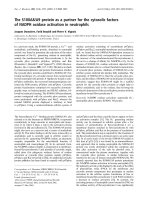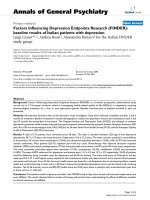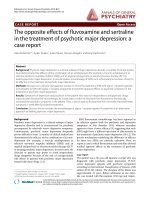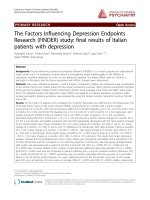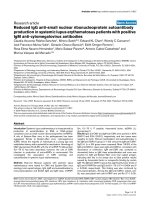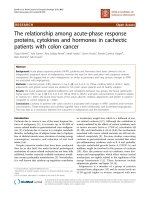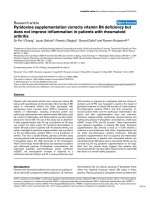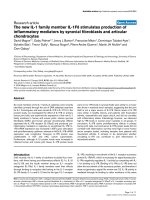Báo cáo y học: "The Factors Influencing Depression Endpoints Research (FINDER) study: final results of Italian patients with depressio" docx
Bạn đang xem bản rút gọn của tài liệu. Xem và tải ngay bản đầy đủ của tài liệu tại đây (250.23 KB, 9 trang )
PRIMARY RESEARCH Open Access
The Factors Influencing Depression Endpoints
Research (FINDER) study: final results of Italian
patients with depression
Rosangela Caruso
1
, Andrea Rossi
2
, Alessandra Barraco
2
, Deborah Quail
3
, Luigi Grassi
1,4*
,
Italian FINDER study group
1
Abstract
Background: Factors Influencing Depression Endpoints Research (FINDER) is a 6-month, prospective, observational
study carried out in 12 European countries aimed at investigating health-related quality of life (HRQoL) in
outpatients receiving treatment for a first or new depressive episode. The Italian HRQoL data at 6 months is
described in this report, and the factors associated with HRQoL changes were determined.
Methods: Data were collected at baseline, 3 and 6 months of treatment. HRQoL was measured using components
of the 36-item Short Form Health Survey (SF-36; mental component summary (MCS), physical component summary
(PCS)) and the European Quality of Life-5 Dimensions (EQ-5D; visual analogue scale (VAS) and health status index
(HSI)). The Hospital Anxiety and Depression Scale (HADS) was adopted to evaluate depressive symptoms, while
somatic and painful physical symptoms were assessed by using the 28-item Somatic Symptom Inventory (SSI-28)
and a VAS.
Results: Of the initial 513 patients, 472 completed the 3-month observatio n and 466 the 6-month observation. The
SF-36 and EQ-5D mean (± SD) scores showed HRQoL improvements at 3 months and a further smaller
improvement at 6 months, with the most positive effect s for SF-36 MCS (baseline 22.0 ± 9.2, 3 months 34.6 ± 10.0;
6 months 39.3 ± 9.5) and EQ-5D HSI (baseline 0.4 ± 0.3; 3 months 0.7 ± 0.3; 6 months 0.7 ± 0.2). Depression and
anxiety symptoms (HADS-D mean at baseline 13.3 ± 4.2; HADS-A mean at baseline 12.2 ± 3.9) consistently
decreased during the first 3 months (8.7 ± 4.3; 7.5 ± 3.6) and showed a further positive change at 6 months (6.9 ±
4.3; 5.8 ± 3.4). Somatic and painful symptoms (SSI and VAS) significa ntly decreased, with the most positive changes
in the SSI-28 somatic item (mean at baseline 2.4 ± 0.7; mean change at 3 months: -0.5; 95% CI -0.6 to -0.5; mean
change at 6 months: -0.7; 95% CI -0.8 to -0.7); in ‘interference of over all pain with daily activities’ (mean at baseline
45.2 ± 30.7; mean change at 3 months -17.4; 95% CI -20.0 to -14.8; mean change at 6 months -24.4; 95% CI -27.3
to -21.6) and in ‘having pain while awake’ (mean at baseline 41.1 ± 29.0; mean change at 3 months -13.7; 95% CI
-15.9 to -11.5; mean change at 6 month s -20.2; 95% CI -22.8 to -17.5) domains. The results from linear regression
analyses showed that the antidepressant switch within classes was consistently associated with a worsening in SF-
36 MCS, EQ-5D VAS and HSI compared to non-switching treatment. Furthermore, between-group antidepressants
(AD) switch was associated with a worse SF-36 MCS and EQ-5D HSI. MCS (P = 0.028), PCS (P = 0.036) and HSI
(P = 0.002) were inversely related to the number of each previous additional depressive episode. PCS (P = 0.009)
and HSI (P = 0.005) were also less improved in patients suffering from a chronic medical condition. Moreover, PCS
(P = 0.044) and EQ-5D VAS (P < 0.0001) worsening was consistently associated with the presence of a psychiatric
illness in the 24 months before baseline. For every additional point on the SSI-somatic score and on the overall
pain VAS score at baseline, HSI score were on average 0.062 (P < 0.001) and 0.001 (P = 0.005) smaller, respectively.
* Correspondence:
1
Section of Psychiatry, Department of Medical Sciences of Communicat ion
and Behaviour, University of Ferrara, Italy
Caruso et al. Annals of General Psychiatry 2010, 9:33
/>© 2010 Caruso et al; licensee BioMed Central Ltd. This is an Open Access article distributed under the terms of the Creative Commons
Attribution License ( .0), which permits unrestricted use, distribution, and reproduction in
any medium, provided the original work is properly cited.
Conclusions: After starting AD treatment, HRQoL improvements at 3 and 6 months were observ ed. However,
several factors can negatively influence HRQoL, such as the presence of somatic and painful symptoms, the
presence of any chronic medical condition or previous psychiatric illness.
Background
The role of depression, a common and debilitating con-
dition, in negatively influencing the quality of li fe of
patients such as functioning b y affecting psychological,
physical and social areas of life has been the object of
intense research over the last few years [1]. Several stu-
dies have investigated these aspects in recent y ears. A
large study of 25,916 primary care patients from several
countries revealed that patients with major depression
reported higher levels of disability than those without
depression [2]. In a different study carried out in Eur-
ope, Lepine et al. [3] found that the degree of disability
was related to severity of depression in patients with
major depressive disorder (MDD).
Goldney et al.[4],bystudyingalargesampleofthe
Australian population, foundthatallthedimensionsof
quality of life, as measured by the 36-item Medical Out-
come Short-Form Health Survey (SF-36), were poorer
among patients with depression (n = 319) with respect
to the non-depressed general population (n = 2,486),
with the poorest level re ached by patients with MDD (n
= 205). Data indicating that the severity of depression
was significant in negatively influencing the quality of
life of patients has been confirmed by Trompenaars
et al. [5], who showed lower levels of quality of life
among patients with major depression with respect to
those with dysthymia and adjustment disorders.
A large population-based study involving 60 countries
has also indicated that depression had the largest effect
on worsening mean health scores compared with other
chronic conditions, including physical diseases, and that
patients with depression comorbid with o ne or more
chronic diseases had the worst health scores of all the
disease states [6].
Somatic symptoms, including pain, are a specific com-
ponent of depression, and were studied as a factor influ-
encing the quality of life of patients. In a recent Spanish
study involving 1,150 primary care patients with a Diag-
nostic and Statistical Manual of Mental Disorders,
fourth edition (DSM-IV)-defined diagnosis of MDD,
García-Campayo et al. [7] found that somatic symptom-
associated disability and a number of somatic symptoms
are strongly associated with increased depression sever-
ity and health resource use, as well as with decreased
quality of life (QOL).
Other factors that may have a great influence on the out-
come of a depressive episode, namely the patient’s psychia-
tric and medical history, the p resence of somatic symptoms,
including painful symp toms, and demographic and social
variables, need to be studied in a prospective way.
Recent results have been reported by the European
Union Factors Influencing Depression Endpoint
Research (EUFINDER), a 6-month, prospective, observa-
tional study carried out in 12 European countries, aimed
at assessing the changes of health-related quality of life
(HRQoL) in outpatients receiving pharmacological treat-
ment for a depressive episode in routine primary care
and s pecialist settings. The study, carried out on 3,468
adult patients with a clinically diagnosed episode of
depression, seems to demonstrate that receiving an anti-
depressant (AD) treatment was associated with improve-
ments in HRQoL, as assessed by the 36-item Short
Form Health Survey (SF-36) and the European Quality
of Life-5 Dimensions (EQ-5D) [8-10]. The baseline
results of patients in the FINDER study in Italy, enrolled
only by specialists, have confirmed a clinically significant
association of depression with clinical and functional
impairments, as well as poor HRQoL [11]. The aim of
the present report is to describe the Italian HRQoL data
at 6 months after starting pharmacotherapy for depres-
sion, and to determine what factors are associated with
HRQoL changes over time.
Methods
Study design and subjects
The de sign and methods of FINDER have been reported
in detail elsewhere [8,9]. Briefly, primary care physicians
or specialists enrolled adult patients responding to the
following inclusion criteria: (i) A clinical diagnosis of
depression; (ii) pharmacological treatment required for
either a first or a new episode of depression; (iii) at least
18 years of age; (iv) no simultaneous participation in a
different study that included an investigational drug or
procedure.
All treatment choices and follow-up care were at the
discretion of the physician and the patient according to
the physician’ s clinical judgment and the local standard
of medical care. The study was approved according to
requirements for ethics and all p atients gave written
informed consent. Following the baseline visit, data were
recorded after approximately 3 and 6 months of therapy,
during routine care visits.
Data collected
At baseline, patient sociodemographic data were
rec orded, along with psychiatric hist ory, duration of the
Caruso et al. Annals of General Psychiatry 2010, 9:33
/>Page 2 of 9
current depressive episode, drugs us ed in t he last 24
months and prescribed at enrolment, and presence of
medical comorbidities. Antidepressants prescribed were
grouped a s follows: selective serotonin reuptake inhibi-
tors (SSRIs: citalopram, escitalopram, fluoxetine, fluvox-
amine, paroxetine, sertraline); serotonin noradrenaline
reuptake inhibitors (SNRIs: venlafaxine); tricyclic and
tetracyclic antidepressants (TCAs: amitriptyline, clomi-
pramine, imipram ine, maprotiline, mianserine, nortripty-
line), others (mirtazapine, phenelzine, reboxetine,
trazodone, lithium), o r combinations of antidepressants
(Table 1).
Instruments
HRQoL was measured using the SF-36 version 2.0 [12]
and the EQ-5D [13]. Severity of anxiety and depression
symptoms were s cored using the Hospital Anxiety and
Depression Scale (HADS) subscales: HADS-D (depres-
sion) and HADS-A (anxiety) [14]. Somatic and painful
symptoms were assessed by using the 28-item Somatic
Symptom Inventory (SSI-28) [15] and a visual analogue
scale (VAS, 0-100) evaluating overall pain severity.
Details regarding the instrument’s use are provided else-
where [9].
Statistical analysis
Descriptive statistics (mean + SD for continuous vari-
ables; percentage for categorical variables) were calcu-
lated f or each variable to describe characteristics of all
513 patients at baseline. However, only those with at
least one follow -up visit were included in the regression
analyses. All confidence intervals were calculated at the
95% level.
Patients were excluded from the analysis if one or
more entry criteria were violated or from individual ana-
lyses based on missing, implausible (according to prede -
fined ranges) or uninterpretable data. The exclusion of
patient data from the analysis was based on study entry
criteria at the first observation, not on whether or not
antidepressant medication was taken during the 6-
mont h follow-up period. Only one patient was excluded
from the analysis (0.2%) due to failure to meet entry
criteria. Data were analysed using SAS V.8.2 (SAS, Cary,
NC, USA).
Loss to follow-up analysis
No predictive analysis was performed for the Italian
subset. Details of the analysis performed for the EUFIN-
DER study were previously described by Reed et al. [10].
Main analysis
Backward regre ssion analysis was performed to identif y
variables independently associated with HRQoL out-
comes. Separate models were fitted for each of the fol-
lowing outcome variables: SF-36 (mental component
summary (MCS), physical component summary (PCS)),
EQ-5D (VAS, health status index (HSI)). A mixed effects
model repeated measures (MMRM) analysis with
unstructured covariance structure was used. Indepen-
dent variables were removed from the full model until
only statistically significant (P ≤ 0.05) variables
remained.
Independent variables in the model included both base-
line as well as post-baseline covariates: score for the
dependent variable at baseline, age, gender, education (2
levels: none/mandatory, further), occupational status (3
levels: ‘working for pay’, ‘unemployed’ , ‘ other’ ), marital
status (married/domestic partner vs other), body mass
index (BMI; continuous) , number of dependants, smok-
ing (yes/no), number of previous epis odes of depression,
age at first episode, any psychiatric illnesses in the 24
months before baseline (yes/no), duration (at baseline) of
the current MDD episode (continuous), HADS anxiety
score (continuous), HADS depression score (continuous),
overall pain VAS score at baseline, SSI-somatic score at
baseline, any chronic medical conditions (yes/no), class
of antidepressant taken between baseline and 6-month
observation, switch of antidepressant after 3 months of
treatment (within AD class, between AD classes, without
AD change). No interaction terms were included.
Results
Sociodemographic data, psychiatric history and medical
comorbidity
Table 1 Medications for depression prescribed at enrolment
SSRI, drugs only, n = 331
(64.5%)
SNRI, drugs only, n = 76
(14.8%)
TCA, drugs only, n = 33
(6.4%)
Other drugs, n = 41
(8.0%)
Combinations, n = 32
(6.2%)
Citalopram Venlafaxine Amytriptyline Mirtazapine
Escitalopram Clomipramine Phenelzine
Fluoxetine Imipramine Reboxetine
Fluvoxamine Maprotiline Trazodone
Paroxetine Mianserin Lithium
Sertraline Nortriptyline
SSRI = selective serotonin reuptake inhibitors; SNRI = serotonin noradrenaline reuptake inhibitors; TCA = tricyclic/tetracyclic antidepressants.
Caruso et al. Annals of General Psychiatry 2010, 9:33
/>Page 3 of 9
Psychiatrists operating in specialist settings enrolled
513 patients from 38 Italian centres. Sociodemographic
and clinical data with the patients’ characteristics are
reported elsewhere, with all the baseline details of the
Italian study [11]. In summ ary, all patients (139 males,
27.1% and 373 females, 72.9%; mean ± SD age 49.2 ±
15.2 years) already had a clinical depression diagnosis.
Approximately half of patients were married and 34.4%
were employed. A total of 302 patients (58.9%) had
received mandatory or no education and 211 (41.1%)
had received further education. The mean (± SD) dura-
tion of depression was 10.6 ± 12.3 years and the mean
(± SD) age at the first depressive episode was 38.7 ±
15.9 years. Approximately half of patients reported at
least one episode of depression in the 24 months before
baseline. Anxiety/panic disorders were the most com-
mon psychiatric comorbidities in the last 24 months
and w ere reported in 72.6% of patients, while 35.9% of
patients had functional somatic syndromes: chronic fati-
gue syndrome (17.1%), irritable bowel syndrome (16.6%)
and atypical chest pain (11.2%) were the most common
ones. Approximately half of the patients reported other
non-psychiatric diseases: a rterial hypertension (25.4%)
and rheumatological disorders (16.2%) were the most
common conditions indicated by physicians from a
checklist o f disorders. In all, 20.3% of patients reported
significant pain (VAS score for overall pain at baseline >
30 mm is considered significant or moderate/severe)
and had a defined medical disorder known to cause
pain, while 44.9% reported significant pain without a
medical disorder known to cause it.
The antidepressants prescribed in at least 10% of
patients were: sertraline (89 patients, 17.3%), escitalo-
pram (83, 16.2%), venlaflaxine (80, 15.6%), paroxetine
(76, 14.8%) and citalopram (62, 12.1%) (Table 1).
Of the initial 513 patients, 472 completed the 3-month
observation (92.0%), and 466 completed the 6-month
observation (90.8%).
HRQoL and clinical changes over time
The mean scores for SF-36 and EQ-5D, at baseline, 3
and 6 months indicated H RQoL improvements at 3
months and further sm aller improvement at 6 months,
with the most positive effects observed f or SF-36 MCS
and EQ-5D HSI. Depression and anxiety symptoms,
scored by using HADS-D and HADS-A subscales con-
sistently decreased during the first 3 months and
showed a further positive change at 6 months (Table 2).
Somatic and painful symptoms, as measured by using
SSI and VAS outcomes, showed significant decreases
over t ime, with the most positive changes observed for
SSI-28 Somatic Item and, as far as VAS is concerned,
for ‘interference of overal l pain with daily activities’ and
‘having pain while awake’ domains (Tables 3 and 4).
Factors associated with HRQoL changes over 6 months
SF-36 MCS
The analysis was performed on a total of 404 patients
having a total of 797 post-baseline observations (see
Table 5). Baseline MCS value was associated with MCS
score through the study with on average scores of MCS
0.35 points greater (P < 0.0001; 95% CI 0.27 to 0.44) for
each additional point on the scale at baseli ne. The MCS
component of SF 36 MCS was significantly associated
with the switch of type or c lass of antidepressant
between the first and second 3-month periods of the
study when compared with no switch during the study
(P < 0.0001). When the switch was between antidepres -
sants belonging to different classes, the average effect
observed with the switch to a different class of AD was
-3.39 points c ompared to no switch (95% CI -6.13 to
-0.65), while the effect when the switch was to an AD
within the same therapeutic class was -8.50 (95% CI
-12.46 to -4.54). MCS was also less improved in patients
who were u nemployed (estimate = -4.45; P = 0.0005;
95% CI -6.96 to -1.94) or with ‘other’ employment status
(estimate = -3.23; P = 0.0002; 95% CI -4.92 t o -1.54)
compared to working for pay.
Finally, the number of previous episodes of depression
was significantly associated with MCS score, with each
additional episode associated with an MCS score -0.68
points lower (P = 0.028; 95% CI -1.29 to -0.07).
SF-36 PCS
The analysis was performed on 371 patients, with a total
of 716 post-baseline observations (Table 6). PCS base-
line value was associated with scores through 3-month
and 6-month observations with o n average scores of
PCS 0.47 points greater (P < 0.0001; 95% CI 0.40 to
0.54). Older age was statistically related to a smaller
improvement of PCS component of SF-36 (estimate =
-0.10; P < 0.0001; 95% CI -0.14 to -0.05). PCS outcome
was also inversely associated to the number of previous
depressive episodes (estimate = -0.47; P = 0.036; 95% CI
-0.90 to -0.03) and with SSI-somatic score at baseline
(estimate = -1.16; P = 0.034 95% CI -2.23 to -0.09). This
means that patients with a higher baseline SSI somatic
score had poorer physical QOL out comes. PCS was also
less improved in patients suffering from a chronic medi-
cal condition (estimate = -1.61; P = 0.009; 95% CI -2.80
to -0.41) and in patients who presented any psychiatric
illnesses in the 24 months before baseline (estimate =
-1.42; P = 0.044; 95% CI -2.80 to -0.04). Better PCS
scores were associated with use of an SNRI (estimate =
3.24; P = 0.014; 95% CI 0.66 to 5.82) or ‘ other drugs’
(estimate = 3.82; P = 0.018; 95% CI 0.67 to 6.97) base-
line and 3-month observation compared to TCA. PCS
improvement was also statistically assoc iated with
HADS-A score at baseline (estimate = 0.24; P = 0.009;
95% CI 0.06 to 0.42;) and with the number of the
Caruso et al. Annals of General Psychiatry 2010, 9:33
/>Page 4 of 9
patient’s dependants (estimate = 0.41; P = 0.050; 95% CI
0.001 to 0.822).
EQ-5D HSI
The analysis was performed on 328 patients, with a total
of 650 post-baseline observations (Table 7). Baseline HSI
values were associated with HSI scores over 6 months
with on average scores of HSI 0.208 points greater (P <
0.0001; 95% CI 0.136 to 0.280) for each additi onal po int
on the scale at baseline.
A small worsening of HSI scores was associated with
the switch to a diff erent antidepressant, when compared
tonoswitch,withsomedifferenceincaseofswitch
between two classes of AD (estimate = -0.071; P =
0.032; 95% CI -0.136 to -0.006) or within the same class
(estimate = -0.222; P < 0.0001; 95% CI -0.323 to -0.121).
HSI outcomes were inversely related to SSI-somatic
scores at baseline (estimate = -0.062; P <0.001;95%CI
-0.09 8 to -0.026) , to the number of pr evious episodes of
depression (estimate = -0.022; P = 0.002; 95% CI -0.036
to -0.008) and to overall pain VAS scores at baseline
(estimate = -0.001; P = 0.005; 95% CI -0.002 to 0.0003).
HSI results were also less i mproved when there was the
presence of a chronic medical condition (estimate =
-0.055; P = 0.005; 95% CI -0.094 to -0.017).
HSI improvement was statistically directly related to
HADS-A scores (estimate = 0.008; P = 0.019; 95% CI
0.001 to 0.013) at baseline and to the number of the
patient’s dependants (estimate = 0.018; P = 0.010; 95%
CI 0.004 to 0.032).
EQ-5D VAS
The analysis was performed on 400 patients, with a total
of 795 observations (Table 8). Baseline EQ-5D VAS
Table 2 SF-36, EQ-5D and HADS values at baseline, 3 months and 6 months
Variable Baseline, mean ± SD 3 Months 6 Months
Mean ± SD 95% CI Mean ± SD 95% CI
SF-36 MCS 22.0 ± 9.2 34.6 ± 10.0 33.7 to 35.6 39.3 ± 9.5 38.4 to 40.1
SF-36 PCS 44.9 ± 9.7 46.9 ± 8.5 46.1 to 47.7 49.0 ± 8.5 48.2 to 49.8
EQ-5D HSI 0.40 ± 0.01 0.66 ± 0.26 0.63 to 0.68 0.74 ± 0.23 0.72 to 0.76
EQ-5D VAS 45.7 ± 19.6 61.3 ± 17.9 59.7 to 63.0 69.3 ± 17.0 67.8 to 70.9
HADS-D 13.3 ± 4.2 8.7 ± 4.3 8.3 to 9.1 6.9 ± 4.3 6.5 to 7.3
HADS-A 12.2 ± 3.9 7.5 ± 3.6 7.2 to 7.8 5.8 ± 3.4 5.5 to 6.1
EQ-5D = European Quality of Life-5 Dimensions; HADS-A/D = Hospital Anxiety and Depression Scale - anxiety/depression; HSI = health status index; MCS =
mental component summary; PCS = physi cal component summary; SF-36 = Short Form 36; VAS = visual analogue scale.
Table 3 Summary statistics for change from baseline in VAS (mm) at 3-month and 6-month observations
Observation N Mean Median SD 95% CI
Baseline Overall VAS score 479 42.9 45.0 27.1 41.7 to 44.1
Severity of headaches during the past week 476 31.5 25.5 28.3 30.2 to 32.8
Severity of back pain during the past week 476 32.8 30.0 28.6 31.5 to 34.1
Severity of shoulder pain during the past week 478 29.7 20.0 29.5 28.4 to 31.0
Interference of overall pain(s) with ability to do daily activities during the past week 477 45.2 47.0 30.7 43.8 to 46.6
Having pain(s) while awake during the past week 479 41.1 40.0 29.0 39.8 to 42.4
3
months
Change in severity of overall pain(s) during the past week 420 -12.9 -10.0 23.1 -15.1 to -10.7
Change in severity of headaches during the past week 417 -9.5 -7.0 24.1 -11.8 to -7.1
Change in severity of back pain during the past week 416 -5.3 -2.0 23.8 -7.6 to -3.0
Change in severity of shoulder pain during the past week 420 -4.9 0.0 25.0 -7.3 to -2.5
Change in interference of overall pain(s) with ability to do daily activities during the past
week
419 -17.4 -12.0 27.5 -20-0 to
-14.8
Change in having pain(s), while awake during the past week 419 -13.7 -10.0 23.2 -15.9 to -11.5
6
months
Change in severity of overall pain(s) during the past week 421 -20.1 -19.0 27.1 -22.7 to -17.5
Change in severity of headaches during the past week 421 -14.5 -10.0 28.0 -17.2 to -11.9
Change in severity of back pain during the past week 419 -10.3 -5.0 27.3 -12.9 to -7.7
Change in severity of shoulder pain during the past week 420 -10.1 -5.0 27.1 -12.7 to -7.5
Change in interference of overall pain(s) with ability to do daily activities during the past
week
420 -24.4 -21.0 30.1 -27.3 to -21.6
Change in having pain(s), while awake during the past week 422 -20.2 -19.0 28.0 -22.8 to -17.5
VAS = visual analogue scale.
Caruso et al. Annals of General Psychiatry 2010, 9:33
/>Page 5 of 9
values were associated with EQ-5D VAS through the
study with on average scores of 0.33 points greater (P <
0.0001; 95% CI 0.26 to 0.40) for each additiona l point
on the scale at baseline.
However, an EQ-5D VAS worsening was consistently
associated with t he switch of antidepressant within the
same class (estimate = -15.51; P < 0.0001; 95% CI -22.66
to -8.36), and with the presence of a psychiatric illness
in the 24 months before baseline (estimate = -7.18; P <
0.0001; 95% CI -10.53 to -3.84). A patient’s occ upational
status appeared to significantly influence EQ-5D VAS
outcomes, as EQ5D VAS was also less improved in
unemployed patients (estimate = -8.46; P < 0.0001; 95%
CI -12.77 to -4.14) and in patients with ‘ other occupa-
tions’ (estimate = -4.16; P = 0.013; 95% CI -7.43 to
-0.89) when compared to patients working for pay.
Older age (estimate = -0.18; P = 0.0005; 95% CI -0.29 to
-0.08) and overall pain VAS values at baseline (estimate =
-0.08; P = 0.004; 95% CI -0.13 to -0.02), showed a statisti-
cal inverse relation with EQ-5D VAS outcomes (Table 8).
Discussion
MDD is often associated with an impaired patient biop-
sychosocial functioning, and with reductions in health-
related quality of life. Nonetheless, the importance of
assessing MDD influence on HRQoL and the role of
MDD clinical symptoms on HRQoL has only recently
been recognised [6,16].
A recent European observational study, EUFINDER,
carried out in 12 countries, evaluated the changes of
HRQoL in outpatients receiving pharmacological treat-
ment for a depressive episode in routine primary care
and specialist settings.
Receiving an AD treatment was associated with la rge
improvements in HRQoL, as assessed by the SF-36 and
the EQ-5D [8,7,10]. In order to understand in a specific
cultural context, such as Italy, the changes in the mea-
sures as assessed in the FINDER study, we have con-
firmed clinical and functional impairments and poor
HRQoL in the baseline assessment [11].
Inthisstudyweexaminedthefollow-updataonthe
Italian FINDER sample in order to verify the role of
depression on HRQoL and found that pat ients with a
clinical diagnosis of depression experienced improve-
ments in HRQoL after starting an a ntidepressant treat-
ment. More specifically, several dimensions of HRQoL
were shown to improve in a 6-month period, including
SF-36, scores, especial ly mental health scores and EQ-
5D HSI.
These results are consistent with a recent longitudin al
study [17], which found reduced EQ-5D scores in Swed-
ish primary care patients with depression compared to
the general populat ion and comparable HRQoL
improvements after 6 months of treatment.
Interestingly, our study al so s howed that the switch o f
antidepressant within AD groups was consistently asso-
ciated with a smaller improvement in SF-36 MCS and
EQ-5D VAS and HSI compared to patients not switch-
ing treatment. Furthermore, between-group AD switch
was associated with a worse SF-36 MCS and EQ-5D
Table 4 Summary statistics for change from baseline in SSI-28 at 3-month and 6-month observations
Observation N Mean Median SD 95% CI
Baseline Summary of SSI-28 mean score 510 2.4 2.3 0.7 2.3 to 2.4
Summary of SSI-28 pain item mean score 498 2.3 2.1 0.8 2.3 to 2.4
Summary of SSI-28 somatic item mean score 511 2.4 2.3 0.7 2.4 to 2.4
3 months Change in SSI-28 mean score 465 0.5 0.4 0.5 0.5 to 0.4
Change in SSI-28 pain item mean score 447 -0.3 -0.3 0.6 -0.4 to -0.3
Change in SSI-28 somatic item mean score 466 -0.5 -0.5 0.6 -0.6 to -0.5
6 months Change in SSI-28 mean score 461 -0.7 -0.6 0.6 -0.7 to -0.6
Change in SSI-28 pain item mean score 441 -0.5 -0.4 0.7 -0.6 to -0.4
Change in SSI-28 somatic item mean score 461 -0.7 -0.7 0.6 -0.8 to -0.7
SSI-28 = 28-item Somatic Symptom Inventory.
Table 5 Factors significantly associated with SF-36 MCS over 6 months of AD treatment
Independent variables F, P value Estimate
MCS at baseline 64, < 0.0001 0.35
Switch within or between AD class (2 df) (reference no switch) 11, < 0.0001 Between -3.39, within -8.50
Occupational status (2 df, reference working for pay) 9, < 0.001 Other -3.23, unemployed -4.45
No. of previous episodes of depression 5, 0.028 -0.68
No. of patients = 404, no. of observations = 797. Switch = change between what was taken between baseline and 3-month observation and what was taken
between the 3-month and 6-month observations.
AD = antidepressants; df = degrees of freedom; MCS = mental component summary; SF-36 = Short Form 36.
Caruso et al. Annals of General Psychiatry 2010, 9:33
/>Page 6 of 9
HSI compared to no switch. This data may be due to
the higher severity of depression in patients requiring a
switch of treatment, to an inappropriate diagnosis or to
inadequate doses/exposure times or inappropriate expo-
sure time rather than to the switching itself. A second
result of our study was that HADS-A scor es at baseline
were positively assoc iated with HRQoL improvements at
6 months. This might be partially due to a positive
effect of participating in the trial, but also to the positive
effects of antidepressant treatments on anxiety.
A third finding is that the presence of a previous psy-
chiatric illness in the 24 months before baseline was
predictive of poorer HRQoL outcomes, with respect to
EQ-5D VAS and, to a lower degree, to SF-36 PCS.
Table 6 Factors significantly associated with SF-36 PCS over 6 months of AD treatment
Independent variables F, P value Estimate 95% CI
PCS at baseline 172, < 0.0001 0.47 0.40 to 0.54
Age 19, < 0.0001 -0.10 -0.14 to -0.05
Any chronic medical conditions (yes vs no) 7, 0.009 -1.61 -2.80 to -0.41
HADS-A at baseline 7, 0.009 0.24 0.06 to 0.42
SSI-somatic at baseline 5, 0.034 -1.16 -2.23 to -0.09
No. of previous episodes of depression 4, 0.036 -0.47 -0.90 to -0.03
Any psychiatric illnesses in the 24 months before baseline observation 4, 0.044 -1.42 -2.80 to -0.04
Class of AD taken between baseline and 3-month observations (4 df) (reference TCA) 2, 0.045 Combinations (NS)
Other drugs 3.82 0.67 to 6.97
SNRI 3.24 0.66 to 5.82
SSRI (NS)
No. of dependants 4, 0.050 0.41 0.001 to 0.822
No. of patients = 371, no. of observations = 716.
AD = antidepressant; df = degrees of freedom; HADS-A = Hospital Anxiety and Depression Scale - anxiety; NS = not significant; PCS = physical component
summary; SF-36 = Short Form 36; SSI = Somatic Symptom Inventory; TCA = tricyclic/tetracyclic antidepressants.
Table 7 Factors significantly associated with EQ-5D HSI over 6 months of AD treatment
Independent variables F, P value Estimate 95% CI
HSI at baseline 32, < 0.0001 0.208 0.136 to 0.280
Switch within or between AD class (2 df) (reference no switch) 11, < 0.0001 Between -0.071 Within -0.222 -0.136 to -0.006 -0.323 to -0.121
SSI-somatic at baseline 12, < 0.001 -0.062 -0.098 to -0.026
No. of previous episodes of depression 9, 0.002 -0.022 -0.036 to -0.008
Any chronic medical conditions (yes vs no) 8, 0.005 -0.055 -0.094 to -0.017
Overall pain VAS at baseline 8, 0.005 -0.001 -0.002 to -0.0003
No. of dependants 7, 0.010 0.018 0.004 to 0.032
HADS-A at baseline 6, 0.019 0.008 0.001 to 0.013
No. of patients = 328, no. of observations = 650. Switch = change between what was taken between baseline and 3-month observation and what was taken
between the 3-month and 6-month observations.
AD = antidepressant; df = degrees of freedom; EQ-5D = European Quality of Life-5 Dimensions; HADS-A, Hospital Anxiety and Depression Scale - anxiety; HSI,
health status index; SSI = Somatic Symptom Inventory; VAS = visual analogue scale.
Table 8 Factors significantly associated with EQ-5D VAS over 6 months of AD treatment
Independent variables F, P value Estimate 95% CI
EQ-5D VAS at baseline 85, < 0.0001 0.33 0.26 to 0.40
Any psychiatric illnesses in the 24 months before baseline 18, < 0.0001 -7.18 -10.53 to -3.84
Switch within or between AD class (2 df) (reference no switch) 9, < 0.001 Between (NS)
Within -15.51 -22.66 to -8.36
Occupational status (2 df, reference working for pay) 8, < 0.001 Other -4.16 -7.43- to -0.89
Unemployed -8.46 12.77 to -4.14
Age 13, < 0.001 -0.18 -0.29 to -0.08
Overall pain VAS at baseline 8, 0.004 -0.08 -0.13 to -0.02
No. of patients = 400, no. of observations = 795. Switch = change between what was taken between baseline and 3-month observation and what was taken
between the 3-month and 6-month observations.
AD = antidepressant; df = degrees of freedom; EQ-5D = European Quality of Life-5 Dimensions; VAS = visual analogue scale.
Caruso et al. Annals of General Psychiatry 2010, 9:33
/>Page 7 of 9
Another result of our study indica tes that a higher
severity of somatic and painful symptoms at base line, as
evaluated by patients, was associated with poorer
HRQoL outcomes during antidepressant treatment. We
also found that the presence of a chronic medical dis-
ease is associated with poorer HRQoL, as far as SF-36
PCS and EQ-5D HSI are concerned. This confirms
other research highlighting the role of somatic and pain-
ful symptoms in the QOL of d epressed patients and
their possible implications on depression outcomes
[7,10,18,19].
There are some limitations that need to be considered
in interpreting the results of the study presented here.
First, important data such as the association between
HRQoL outcomes and AD switching need to be further
investigated in more controlled settings. A second lim-
itation is that this study did not include a control group,
for example a group of patients not starting an AD
treatment. As a third limitation, HRQoL measures eval-
uate concepts also included in instruments that assess
depression. However, SF-36 and EQ-5D focus more on
the patients’ daily liv ing, social interactions and related
aspects. Symptom severity and impact on everyday life
are probably closely correlated, which may explain
much of the parallel improvement in HRQoL and
depression symptoms. Furthermore, the b road number
of rating scales used in the study limited the practicabil-
ity of a longer follow-up. This may have in part condi-
tioned findings related to the effects of antidepressant
treatment on HRQoL. Lastly, during our observation
period, patients did not reach the general population
average of 50 for the SF-36 MCS (MCS mean value at 6
months = 39.3). Thus, a longer observation period
might be needed to assess whether, for patients with
depressive disorders, the time for achieving mental
HRQoL outcomes comparable to the general po pulation
is longer than 6 months or whether, even after treat-
ment with antidepressants, in these patients HRQoL
remains impaired.
Conclusions
Our study underlined that thepresenceofsomaticand
painful symptoms, chronic medical conditions or pre-
vious psychiatric illnesses are to be taken into account
when offering treatment to a depressed patient, as they
can negatively influence HRQoL. Moreover depressed
patients with higher levels of somatic an d painful symp-
toms may respond less to treatment than other patients.
A consequent clinical implication of these findings is
that specific pharmacological profiles could be consid-
ered when prescribing antidepressants (for example,
SSRIs and SNRIs) to p atients reporting painful physical
symptoms.
Furthermore, our study showed that switching
between different A D classes was consistently associated
with poorer HRQoL outcomescomparedtopatients
able to remain within the same class of AD.
Acknowledgements
The authors would like to thank Luca Cantini for his contribution in medical
writing and Pierluigi Crisà and Stefania Gemmi for their contribution to
study coordination and data collection, Catherine Reed for the overall
FINDER study coordination. Special thanks are extended to the Italian
FINDER study group for its contribution in acquisition of data.
The Italian FINDER study group are: Eugenio Aguglia, Trieste; Luigi Arturo
Ambrosio, Cosenza; Nicolò Baldini Rossi, Bologna; Antonello Bellomo, Foggia;
Giancarlo Belloni, Magenta; Massimo Biza, Bergamo; Nunzio Bucci, Taranto;
Raffaele Cappuccio, S. Antimo; Maria Gabriella Carboni, Sassari; Gianpiero
Cesari, Arezzo; Fabrizio Ciappi, Città di Castello; Anna Maria Cipriani, Roma;
Luciano Cordioli, Isola della Scala; Vincenzo Delcuratolo, Barletta; Antonio Di
Cello Lamezia Terme; Mario Di Fiorino, Viareggio; Andrea Di Lauro, Caserta;
Vincenzo Falabella, Napoli; Stefania Falavolti, Ladispoli; Giorgio Farina,
Omegna; Tommaso Federico, Catania; Carlo Ferrarese, Monza; Filippo
Gabrielli, Genova; Giuseppe Gazzera, Savigliano; Luigi Grassi, Ferrara; Giorgio
Mariani, Ascoli Piceno; Giampaolo Minnai, Oristano; Domenico Nano, N ovara;
Giuseppe Nicolo’, Roma; Lucilla Parnetti, Perugia; Giampaolo Pierri, Bari; Mario
Puoti, Roma; Alessandro Riccio, Torino; Antonella Romeo, Vittorio Veneto; Ilo,
Lugo; Paolo Rossi Prodi, Firenze; Mario Serrano, Livorno; Sandro Sorbi,
Firenze; Emanuele Toniolo, Rovigo; Raimondo Venanzini, Fano; Simone
Vender, Varese; Marco Venuta, Modena; Maurizio Volpe, Benevento.
Author details
1
Section of Psychiatry, Department of Medical Sciences of Communicat ion
and Behaviour, University of Ferrara, Italy.
2
Medical Department, Eli Lilly Italia,
Sesto Fiorentino, Italy.
3
Eli Lilly and Company Limited, Lilly Research Centre,
Windlesham, UK.
4
Integrated Department of Mental Health and Drug abuse,
NHS Local Health Agency, Ferrara, Italy.
Authors’ contributions
AR and AB made substantial contributions to analysis and interpretation of
data, and in the revision of the manuscript. DQ made substantial
contributions to statistical analyses and to the revision of the manuscript. LG
made relevant contribution in the recruitment of patients, in the critical
revision of the manuscript. RC made substantial contributions in the analysis
and interpretation of data and in the manuscript writing. All authors gave
final approval for the article.
Competing interests
AB and AR are employees at Eli Lilly Italia.
Received: 30 November 2009 Accepted: 29 July 2010
Published: 29 July 2010
References
1. Papakostas GI, Petersen T, Mahal Y, Mischoulon D, Nierenberg AA, Fava M:
Quality of life assessments in major depressive disorder: a review of the
literature. Gen Hosp Psychiatry 2004, 26:13-17.
2. Ormel J, Vonkorff M, Ustun TB, Pini S, Korten A, Oldehinkel T: Common
mental disorders and disability across cultures. Results from the WHO
Collaborative Study on Psychological Problems in General Health Care.
JAMA 1994, 272:1741-1748.
3. Lepine JP, Gastpar M, Mendlewicz J, Tylee A: Depression in the
community: the first pan-European study DEPRES [Depression Research
in European Society]. Int Clin Psychopharmacol 1997, 12:19-29.
4. Goldney RD, Fisher LJ, Wilson DH, Cheok F: Major depression and its
associated morbidity and quality of life in a random, representative
Australian community sample. Aust N Z J Psychiatry 2000, 34:1022-1029.
5. Trompenaars FJ, Masthoff ED, Van Heck GL, Hodiamont PP, De Vries J:
Relationship between mood related disorders and quality of life in a
population of Dutch adult psychiatric outpatients. Depress Anxiety 2006,
23:353-363.
Caruso et al. Annals of General Psychiatry 2010, 9:33
/>Page 8 of 9
6. Moussavi S, Chatterji S, Verdes E, Tandon A, Patel V, Ustun B: Depression,
chronic diseases, and decrements in health: results from the World
Health Surveys. Lancet 2007, 370:851-858.
7. García-Campayo J, Ayuso-Mateos JL, Caballero L, Romera I, Aragonés E,
Rodríguez-Artalejo F, Quail D, Gilaberte I: Relationship of somatic
symptoms with depression severity, quality of life, and health resources
utilization in patients with major depressive disorder seeking primary
health care in Spain. Prim Care Companion J Clin Psychiatry 2008,
10:355-362.
8. Bauer M, Monz BU, Montejo AL, Quail D, Dantchev N, Demyttenaere K,
Garcia-Cebrian A, Grassi L, Perahia DG, Reed C, Tylee A: Prescribing
patterns of antidepressants in Europe: results from the Factors
Influencing Depression Endpoints Research (FINDER) study. Eur Psychiatry
2008, 23:66-73.
9. Garcia-Cebrian A, Bauer M, Montejo AL, Dantchev N, Demyttenaere K,
Gandhi P, Grassi L, Monz BU, Perahia DG, Quail D, Tylee A: Factors
influencing depression endpoints research (FINDER): study design and
population characteristics. Eur Psychiatry 2008, 23:57-65.
10. Reed C, Monz BU, Perahia DG, Gandhi P, Bauer M, Dantchev N,
Demyttenaere K, Garcia-Cebrian A, Grassi L, Quail D, Tylee A, Montejo AL:
Quality of life outcomes among patients with depression after 6 months
of starting treatment: results from FINDER. J Affect Disord 2009,
113:296-302.
11. Grassi L, Rossi A, Barraco A, for the Italian FINDER study group: Factors
Influencing Depression Endpoints Research (FINDER): baseline results of
Italian patients with depression. Ann Gen Psychiatry 2009, 8:14.
12. Ware JE Jr, Gandek B: Methods for testing data quality, scaling
assumptions, and reliability: the IQOLA Project approach. International
Quality of Life Assessment. J Clin Epidemiol 1998, 51:945-952.
13. Brooks R: Quality of life measures. Crit Care Med 1996, 24:1769.
14. Zigmond AS, Snaith RP: The hospital anxiety and depression scale. Acta
Psychiatr Scand 1983, 67:361-370.
15. Barsky AJ: Palliation and symptomatic relief. Arch Intern Med 1986,
146:905-909.
16. Trivedi MH, Rush AJ, Wisniewski SR, Warden D, McKinney W, Downing M,
Berman SR, Farabaugh A, Luther JF, Nieremberg AA, Callan JA, Sackeim HA:
Factors associated with health-related-quality of life among outpatients
with major depressive disorder: a STAR-D Report. J Clin Psychiatry 2006,
67:185-95.
17. Sobocki P, Ekman M, Ågren H, Krakau I, Runeson B, Mårtensson B,
Jönsson B: Health-related quality of life measured with EQ-5D in patients
treated for depression in primary care. Value Health 2007, 10:153-160.
18. Tylee A, Gandhi P: The importance of somatic symptoms in depression in
primary care. Prim Care Compan J Clin Psychiatry 2005, 7:167-176.
19. Demyttenaere K, Reed C, Quail D, Bauer M, Dantchev N, Montejo AL,
Monz B, Perahia D, Tylee A, Grassi L: Presence and predictors of pain in
depression: results from the FINDER study. J Affect Disord
2010.
doi:10.1186/1744-859X-9-33
Cite this article as: Caruso et al.: The Factors Influencing Depression
Endpoints Research (FINDER) study: final results of Italian patients with
depression. Annals of General Psychiatry 2010 9:33.
Submit your next manuscript to BioMed Central
and take full advantage of:
• Convenient online submission
• Thorough peer review
• No space constraints or color figure charges
• Immediate publication on acceptance
• Inclusion in PubMed, CAS, Scopus and Google Scholar
• Research which is freely available for redistribution
Submit your manuscript at
www.biomedcentral.com/submit
Caruso et al. Annals of General Psychiatry 2010, 9:33
/>Page 9 of 9
